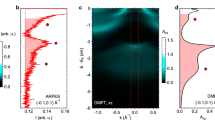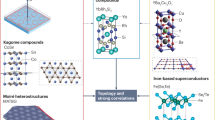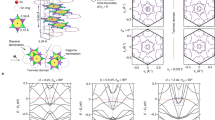Abstract
The properties of condensed matter are determined by single-particle and collective excitations and their mutual interactions. These quantum-mechanical excitations are characterized by an energy, E, and a momentum, ℏk, which are related through their dispersion, Ek. The coupling of excitations may lead to abrupt changes (kinks) in the slope of the dispersion. Kinks thus carry important information about the internal degrees of freedom of a many-body system and their effective interaction. Here, we report a novel, purely electronic mechanism leading to kinks, which is not related to any coupling of excitations. Namely, kinks are predicted for any strongly correlated metal whose spectral function shows a three-peak structure with well-separated Hubbard subbands and a central peak, as observed, for example, in transition-metal oxides. These kinks can appear at energies as high as a few hundred millielectron volts, as found in recent spectroscopy experiments on high-temperature superconductors1,2,3,4 and other transition-metal oxides5,6,7,8. Our theory determines not only the position of the kinks but also the range of validity of Fermi-liquid theory.
This is a preview of subscription content, access via your institution
Access options
Subscribe to this journal
Receive 12 print issues and online access
$259.00 per year
only $21.58 per issue
Buy this article
- Purchase on SpringerLink
- Instant access to full article PDF
Prices may be subject to local taxes which are calculated during checkout


Similar content being viewed by others
References
Graf, J. et al. A universal high energy anomaly in the electron spectrum of high temperature superconductors by angle—possible evidence of spinon and holon branches. Phys. Rev. Lett. (2006) (in the press) <http://www.arxiv.org/cond-mat/0607319>.
Valla, T. et al. High-energy kink in high-temperature superconductors. Preprint at <http://www.arxiv.org/cond-mat/0610249> (2006).
Pan, Z.-H. et al. Universal quasiparticle decoherence in hole- and electron-doped high-Tc cuprates. Preprint at <http://www.arxiv.org/cond-mat/0610442> (2006).
Meevasana, W. et al. The hierarchy of multiple many-body interaction scales in high-temperature superconductors. Preprint at <http://www.arxiv.org/cond-mat/0612541> (2006).
Aiura, Y. et al. Kink in the dispersion of layered strontium ruthenates. Phys. Rev. Lett. 93, 117005 (2004).
Iwasawa, H. et al. Orbital selectivity of the kink in the dispersion of Sr2RuO4 . Phys. Rev. B 72, 104514 (2005).
Yoshida, T. et al. Direct observation of the mass renormalization in SrVO3 by angle resolved photoemission spectroscopy. Phys. Rev. Lett. 95, 146404 (2005).
Sun, Z. et al. Quasiparticle-like peaks, kinks, and electron-phonon coupling at the (π,0) regions in the CMR oxide La2−2xSr1+2xMn2O7 . Phys. Rev. Lett. 97, 056401 (2006).
Hengsberger, M., Purdie, D., Segovia, P., Garnier, M. & Baer, Y. Photoemission study of a strongly coupled electron-phonon system. Phys. Rev. Lett. 83, 592–595 (1999).
Valla, T., Fedorov, A. V., Johnson, P. D. & Hulbert, S. L. Many-body effects in angle-resolved photoemission: Quasiparticle energy and lifetime of a Mo(110) surface state. Phys. Rev. Lett. 83, 2085–2088 (1999).
Rotenberg, E., Schaefer, J. & Kevan, S. D. Coupling between adsorbate vibrations and an electronic surface state. Phys. Rev. Lett. 84, 2925–2928 (2000).
Lanzara, A. et al. Evidence for ubiquitous strong electron–phonon coupling in high-temperature superconductors. Nature 412, 510–514 (2001).
Shen, Z.-X., Lanzara, A., Ishihara, S. & Nagaosa, N. Role of the electron-phonon interaction in the strongly correlated cuprate superconductors. Phil. Mag. B 82, 1349–1368 (2002).
He, H. et al. Resonant spin excitation in an overdoped high temperature superconductor. Phys. Rev. Lett. 86, 1610–1613 (2001).
Hwang, J., Timusk, T. & Gu, G. D. High-transition-temperature superconductivity in the absence of the magnetic-resonance mode. Nature 427, 714–717 (2004).
Higashiguchi, M. et al. High-resolution angle-resolved photoemission study of Ni(1 1 0). J. Electron Spectrosc. Relat. Phenom. 144–147, 639–642 (2005).
Schäfer, J. et al. Electronic quasiparticle renormalization on the spin wave energy scale. Phys. Rev. Lett. 92, 097205 (2004).
Menzel, A. et al. Correlation in low-dimensional electronic states on metal surface. New J. Phys. 7, 102 (2005).
Ronning, F. et al. Evolution of a metal to insulator transition in Ca2−xNaxCuO2Cl2 as seen by angle-resolved photoemission. Phys. Rev. B 67, 165101 (2003).
Yang, H.-B. et al. Fermi surface evolution and Luttinger theorem in NaxCoO2: a systematic photoemission study. Phys. Rev. Lett. 95, 146401 (2005).
Bostwick, A., Ohta, T., Seyller, T., Horn, K. & Rotenberg, E. Quasiparticle dynamics in graphene. Nature Phys. 3, 36 (2007).
Abrikosov, A. A., Gorkov, L. P. & Dzyaloshinski, I. E. Methods of Quantum Field Theory in Statistical Physics (Dover, New York, 1975).
Metzner, W. & Vollhardt, D. Correlated lattice fermions in d=∞ dimensions. Phys. Rev. Lett. 62, 324–327 (1989).
Pruschke, Th., Jarrell, M. & Freericks, J. K. Anomalous normal-state properties of high- T c superconductors: intrinsic properties of strongly correlated electron systems? Adv. Phys. 44, 187–210 (1995).
Georges, A., Kotliar, G., Krauth, W. & Rozenberg, M. J. Dynamical mean-field theory of strongly correlated fermion systems and the limit of infinite dimensions. Rev. Mod. Phys. 68, 13–125 (1996).
Kotliar, G. & Vollhardt, D. Strongly correlated materials: Insights from dynamical mean-field theory. Phys. Today 57, 53–59 (2004).
Nekrasov, I. A. et al. Momentum-resolved spectral functions of SrVO3 calculated by LDA+DMFT. Phys. Rev. B 73, 155112 (2006).
Bulla, R., Pruschke, Th. & Hewson, A. C. Metal-insulator transition in the Hubbard model. Physica B 259–261, 721–722 (1999).
Acknowledgements
We acknowledge discussions with V. I. Anisimov, R. Bulla, J. Fink, A. Fujimori and D. Manske. This work was supported by the Deutsche Forschungsgemeinschaft through Sonderforschungsbereiche 484 (K.B., M.K., D.V.) and 602 (T.P.) and the Emmy-Noether program (K.H.), and in part by the Russian Basic Research foundation grants 05-02-16301, 05-02-17244, 06-02-90537 as well as by the RAS Programs ‘Quantum macrophysics’ and ‘Strongly correlated electrons in semiconductors, metals, superconductors and magnetic materials’, Dynasty Foundation, Grant of President of Russia MK-2118.2005.02, interdisciplinary grant UB-SB RAS (I.N.). We thank the John von Neumann Institute for Computing, Forschungszentrum Jülich and the Norddeutsche Verbund für Hoch- und Höchstleistungsrechnen for computing time.
Author information
Authors and Affiliations
Corresponding authors
Ethics declarations
Competing interests
The authors declare no competing financial interests.
Supplementary information
Rights and permissions
About this article
Cite this article
Byczuk, K., Kollar, M., Held, K. et al. Kinks in the dispersion of strongly correlated electrons. Nature Phys 3, 168–171 (2007). https://doi.org/10.1038/nphys538
Received:
Accepted:
Published:
Issue date:
DOI: https://doi.org/10.1038/nphys538
This article is cited by
-
Strong band renormalization and emergent ferromagnetism induced by electron-antiferromagnetic-magnon coupling
Nature Communications (2022)
-
Effect of Short-Range Correlations on Spectral Properties of Doped Mott Insulators
Journal of Superconductivity and Novel Magnetism (2019)
-
Quasiparticle interference and strong electron–mode coupling in the quasi-one-dimensional bands of Sr2RuO4
Nature Physics (2017)
-
Anomalous High-Energy Waterfall-Like Electronic Structure in 5 d Transition Metal Oxide Sr2IrO4 with a Strong Spin-Orbit Coupling
Scientific Reports (2015)
-
Anisotropic breakdown of Fermi liquid quasiparticle excitations in overdoped La2−xSrxCuO4
Nature Communications (2013)



